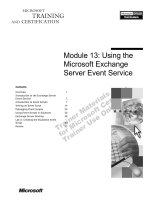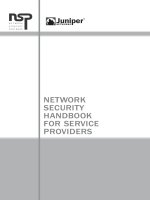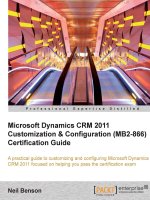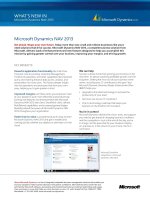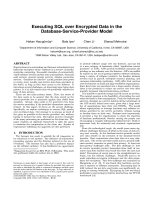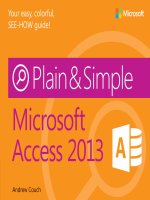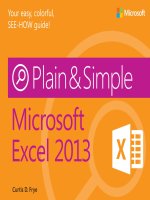microsoft dynamics crm 2013 service provider
Bạn đang xem bản rút gọn của tài liệu. Xem và tải ngay bản đầy đủ của tài liệu tại đây (1.6 MB, 106 trang )
Microsoft Dynamics CRM 2013 Service
Provider Planning and Deployment Guide
Copyright
This document is provided "as-is". Information and views expressed in this document, including URL and other Internet website
references, may change without notice. You bear the risk of using it.
Some examples depicted herein are provided for illustration only and are fictitious. No real association or connection is intended or
should be inferred.
This document does not provide you with any legal rights to any intellectual property in any Microsoft product. You may copy and
use this document for your internal, reference purposes.
© 2013 Microsoft Corporation. All rights reserved.
Microsoft may have patents, patent applications, trademarks, copyrights, or other intellectual property rights covering subject matter
in this document. Except as expressly provided in written license agreement from Microsoft, the furnishing of this document does not
give you any license to these patents, trademarks, copyrights, or other intellectual property.
Complying with all applicable copyright laws is the responsibility of the user. Without limiting the rights under copyright, no part of
this document may be reproduced, stored in or introduced into a retrieval system, or transmitted in any form or by any means
(electronic, mechanical, photocopying, recording, or otherwise), or for any purpose, without the express written permission of
Microsoft Corporation.
For more information, see Use of Microsoft Copyrighted Content at
Microsoft, Active Directory, IntelliSense, Internet Explorer, Microsoft Dynamics, the Microsoft Dynamics logo, Outlook, SQL
Server, Visual Studio, Windows, Windows PowerShell, Windows Server, Windows Server System, and Windows Vista are either
registered trademarks or trademarks of Microsoft Corporation in the United States and/or other countries. Microsoft products
mentioned herein may be either registered trademarks or trademarks of Microsoft Corporation in the United States and/or other
countries. All other trademarks are property of their respective owners.
iii
Table of Contents
1 Introduction 1
1.1 Who Should Read This Document 1
1.2 Scope and Assumptions 1
2 Deployment Overview 2
2.1 Summary of Deployment Process 2
2.2 Deploying CRM as a Hosted Service 4
2.2.1 Infrastructure for CRM Dynamics Hosting 4
2.2.2 High Availability in Infrastructure 5
2.2.3 Installation Privileges Requirements 7
2.3 Architectural Planning and Considerations 7
2.3.1 CRM Services 7
2.3.2 Network Segmentation 10
2.3.3 Internet-facing Deployment of CRM 11
2.3.4 Deployment Groups 11
2.3.5 Architectural Tiers 12
2.3.6 Backup and Restore Considerations 19
2.3.7 Planning for Email Processing using Server-Side Synchronization 20
3 Deployment Installation 22
3.1 Example Names 22
3.1.1 Server Names, Roles, and Associated Software 22
3.1.2 Claims-based Authentication Considerations 24
3.1.3 Example Domain Names 24
3.2 Deploy the Hosted Microsoft Dynamics CRM Infrastructure 25
3.2.1 Prepare the Active Directory Forest Domain Infrastructure 25
3.2.2 Build and Deploy the External DNS Server 25
3.2.3 Determine the Multi-tenancy Design 26
3.2.4 Build and Deploy the Messaging Platform 26
3.2.5 Deploy Federation and Claims-based Authentication Platform 26
3.3 Deploy Hosted Microsoft Dynamics CRM Deployment Group Components 27
3.3.1 Deploy Hosted Microsoft Dynamics CRM 2013 Database Server 28
3.3.2 Deploy the CRM Front-end Servers 29
3.3.3 Install the Back-end Servers 32
3.3.4 Deploy Deployment Administration Servers 34
3.4 Email Processing through Server-Side Synchronization 35
3.4.1 Create the CRM Exchange Administrator Account 35
3.4.2 Create email server profiles 36
3.5 Deploy SharePoint Grid 39
3.6 Scripting Deployment Installations with Configuration Files 39
3.7 Deploy CRM for Outlook 40
4 Post-Installation Configuration and Management 41
4.1 Microsoft Dynamics CRM 2013 Best Practices Analyzer 41
4.1.1 Best Practices Analyzer requirements 41
4.1.2 Installation instructions 41
4.1.3 Run a scan using the Best Practices Analyzer 42
iv
4.1.4 Add Deployment Administrators 42
4.1.5 Creating a New CRM Deployment Administrator Account 42
4.1.6 Creating a New CRM Deployment Administrators Group 42
4.1.7 Adding Deployment Administrator Group to CRM Server Local Administrators
Group 42
4.1.8 Granting CRM Deployment Administrator Permissions to the CRM Active Directory
Groups 43
4.1.9 Granting CRM Deployment Administrators Permissions to CRM SQL Objects 44
4.1.10 Adding Domain User Account to CRM Deployment Administrators Group 45
4.1.11 Adding User as a CRM Deployment Administrator in CRM Deployment Manager 45
4.1.12 Adding a Deployment Administrator 46
4.2 Configure Claims and IFD 46
4.2.1 Configuring the Microsoft Dynamics CRM Server 2013 Websites for SSL/HTTPS 46
4.2.2 Configuring Fault Tolerance and Firewall 47
4.2.3 Configuring Microsoft Dynamics CRM Server 2013 for Claims-based
Authentication 48
4.2.4 Configuring the AD FS 2.0 Server for Claims-based Authentication 49
4.2.5 Configuring Microsoft Dynamics CRM 2013 for Internet-facing Deployment 50
5 Upgrade Guidance 52
5.1 Design Hosted Microsoft Dynamics CRM 2013 54
5.2 Deploy Hosted Microsoft Dynamics CRM 2013 54
5.3 Upgrade CRM 2011 Organization to CRM 2013 54
5.3.1 Upgrade Options 54
5.3.2 Software Prerequisites 55
5.3.3 Migrate by using a new instance of SQL Server 55
5.3.4 Backing up CRM 2011 Organization Database 55
5.3.5 Restoring CRM 2011 Organization Database into CRM 2013 SQL 56
5.3.6 Importing CRM 2011 Organization Database into CRM 2013 56
5.3.7 Modifying DNS Records for CRM Organization 58
5.3.8 Migrate settings from the Email Router to server-side synchronization 58
5.3.9 Enabling Anonymous Authentication for the Discovery Web Service 59
5.3.10 Refreshing the CRM Organization Identifiers in AD FS 59
5.4 Verify Access Using Web Client and Outlook 59
5.4.1 Verify the Web Client 59
5.4.2 Verify the CRM for Outlook Client 60
5.5 Upgrade the CRM for Outlook Client 60
6 Provisioning 62
6.1 Manual Provisioning 62
6.1.1 Creating, Importing, Editing Organizations 62
6.1.2 Business Unit Provisioning 68
6.1.3 User Provisioning 68
6.1.4 Enabling CRM Organization and Users for Email Routing 69
6.1.5 Security Role Provisioning 73
6.1.6 Field Security Profile Provisioning 74
6.1.7 Language Provisioning 75
6.1.8 Troubleshooting Options 75
6.2 Automated Provisioning 75
6.2.1 Prerequisites 76
6.2.2 Using the CRM Dynamics 2013 Deployment Web Service to Provision Tenant
Organizations 76
: Introduction
v
6.2.3 Using the CRM Dynamics 2013 Web Services to Provision Tenant Organization
Objects 83
1
Chapter 1
1 Introduction
Welcome to the Microsoft Dynamics CRM 2013 Service Provider Planning and Deployment Guide. This
document provides instructions and steps for deploying and running hosted Microsoft Dynamics
®
CRM in a
Microsoft
®
Windows Server System™ hosting environment.
The hosted Microsoft Dynamics CRM service is built around Microsoft Dynamics CRM 2013. By deploying a
hosted Microsoft Dynamics CRM environment, service providers can offer advanced customer relationship
management (CRM) functionality to business customers over the Internet.
Because deploying hosted Microsoft Dynamics is based on the Microsoft Dynamics CRM 2013 product, the
details in this document build on the information discussed in the main Microsoft Dynamics CRM 2013
Implementation Guide, and should be considered a supplement to the main product documentation.
1.1 Who Should Read This Document
This document is intended for service provider IT personnel, system integrators, and technical consultants
who may assist in the planning and deployment of hosted Microsoft Dynamics CRM 2013.
The technical nature of a Microsoft Dynamics CRM 2013 deployment assumes Microsoft Certified Systems
Engineer (MCSE)-level skills, particularly with Microsoft Exchange Server 2003, 2007, 2010 or 2013, Microsoft
SQL Server
®
2008 (SP1 or later) or 2012, Microsoft Windows Server
®
2008 (SP2 or later) or 2012 RTM, and
Microsoft Active Directory
®
. If you need assistance with your implementation, you may consider hiring a
systems integrator that specializes in Microsoft Dynamics CRM deployments.
Upon completion of the deployment walkthrough, you should be able to confirm that you have a fully
functioning hosted Microsoft Dynamics CRM environment, and are able to provision customers and users
either manually or automatically (by integrating these concepts with internally developed provisioning scripts or
third-party automation solutions).
1.2 Scope and Assumptions
Readers of this document should first familiarize themselves with the documentation for Microsoft Dynamics
CRM 2013. This document focuses on the special considerations and installation procedures required to
deploy a hosted Microsoft Dynamics CRM environment; information that is common to an enterprise
deployment of Microsoft Dynamics CRM 2013 in general is not duplicated.
For more information about the Microsoft Dynamics CRM 2013 documentation, go to the Microsoft Dynamics
CRM 2013 and Microsoft Dynamics CRM Online Implementation Guide.
This document provides guidance on how to prepare your environment and how to properly install and
configure hosted Microsoft Dynamics CRM 2013. Information about supporting components and systems is
also provided.
Chapter 2: Deployment Overview
2
Chapter 2
2 Deployment Overview
This deployment guide details the hosted Microsoft Dynamics CRM installation starting with the server
operating system installation. Even if you have pre-existing servers, you should read this chapter carefully to
ensure your current infrastructure meets the prerequisites for each server.
2.1 Summary of Deployment Process
The following flowchart helps direct you to the appropriate sections of this document.
Chapter 2: Deployment Overview
3
Figure 1: Flowchart indicates the appropriate sections to read in this document
Chapter 2: Deployment Overview
4
The following sections provide summary descriptions of the multi-tenant deployment and upgrade process for
Microsoft Dynamics CRM 2013.
2.2 Deploying CRM as a Hosted Service
The primary focus of this document is to provide complete deployment instructions for Microsoft Dynamics
CRM 2013 in a multi-tenant (hosted) environment. Because hosted Microsoft Dynamics CRM 2013 requires a
variety of supporting infrastructure to be in place before the actual CRM deployment process begins, the
deployment instructions reference the installation and configuration of Microsoft Active Directory, Microsoft
Exchange Server, and other required servers. Only after these supporting technologies have been properly
installed will you be directed to deploy the CRM-specific components.
2.2.1 Infrastructure for CRM Dynamics Hosting
Microsoft Dynamics CRM requires several software applications and components that work together to create
an effective system. The majority of the system requirements for a hosted Microsoft Dynamics CRM 2013
environment are similar to the on-premises deployment of Microsoft Dynamics CRM 2013.
Before you install hosted Microsoft Dynamics CRM, use this chapter as a guide to verify that system
requirements are met and the necessary software components are available. See the pages referenced in the
following list for the most current information available on supported software components, and the minimum
recommendations for hardware:
Microsoft Dynamics CRM Server 2013
Microsoft Dynamics CRM Server 2013 hardware requirements
Microsoft Dynamics CRM system requirements and required technologies
Microsoft SQL Server for Microsoft Dynamics CRM Server 2013
Microsoft SQL Server hardware requirements for Microsoft Dynamics CRM Server 2013
Microsoft Dynamics CRM Server-side Synchronization
Supported scenarios for server-side synchronization
2.2.1.1 Active Directory Details
Microsoft Dynamics CRM 2013 uses Microsoft Active Directory to store user and group information, and
application security associations. Depending on the multi-tenant Active Directory design, how organizations
and users are stored and secured varies. However, there are common requirements and considerations for
the Active Directory infrastructure for Dynamics CRM, which can be found at Active Directory and network
requirements for Microsoft Dynamics CRM 2013.
Active Directory Federated Services 2.1 (AD FS 2.1) is one of the components involved in providing claims-
based authentication for Microsoft Dynamics CRM Server 2013.You need to deploy a Security Token Service
to prepare for later deploying claims-based authentication for your internet-facing deployment. You can use
the Federation Service role as a security token service. To learn more about this, see:
Understanding the Federation Service Role Service
Active Directory Federation Services
Read more about the prerequisites for deploying claims-based authentication in " About claims-based
authentication " in the Microsoft Dynamics CRM 2013 Implementation Guide, available for download at
Chapter 2: Deployment Overview
5
2.2.1.2 SQL Server Details
How you choose to deploy SQL Server as part of your hosting infrastructure will depend on a number of
factors, many of which are discussed in more detail below. Before starting to think through issues of
availability and scalability, you should familiarize yourself with these SQL Server topics:
SQL Server requirements and recommendations for Microsoft Dynamics CRM
SQL Server installation and configuration
SQL Server Deployment
Planning a SQL Server Installation
Additional resources for SQL Server
2.2.1.3 Email processing through server-side synchronization
The Server-side synchronization can be configured to connect to one or more email servers running Microsoft
Exchange Server. Server-side synchronization can also connect to POP3-compliant servers to provide
incoming email routing. For outgoing email, you can use SMTP and Exchange Web Services (EWS). For more
information about the email server versions and protocols that Microsoft Dynamics CRM 2013 supports, see
Email processing through server-side synchronization.
Exchange Server is an enterprise messaging system with the versatility to support various organizations. As
with Active Directory Service and Microsoft Dynamics CRM, Exchange Server requires planning before it is
deployed. Many documents are available from Microsoft that explain how to plan, deploy, and operate
Exchange Server. For more information, see Additional resources for Exchange Server.
To begin the default deployment process for hosted Microsoft Dynamics CRM 2013, see Deploy the Hosted
Microsoft Dynamics CRM Infrastructure, later in this guide.
2.2.2 High Availability in Infrastructure
In many ways, Hosted Microsoft Dynamics CRM Server 2013 deployments are similar to on-premises
deployments. They can include multiple servers, which provide additional performance and scaling benefits.
Note
The Microsoft Dynamics CRM Workgroup Server 2013 does not support more than one tenant
organization, and is limited to five active users. This limitation means that this edition is not a
reasonable choice for a service provider implementing a multi-tenant hosting environment for
Microsoft Dynamics CRM.
2.2.2.1 Front-end and Authentication Fault Tolerance
Consider how to provide fault tolerance for your front-end servers. In Microsoft Dynamics CRM Server 2013,
you can install specific server functionality, components, and services on different computers. These
components and services correspond to specific server roles. For a hosting implementation, the number of
front-end servers and the associated configuration details will vary depending on the total number of
organizations and totally number of users the deployment needs to support. As expected in a hosted
environment, the CRM deployment will serve many users across multiple tenant organizations. In addition,
Service Level Agreements (SLAs) are likely in place between the service provider and customers that demand
high availability from the platform.
To support SLA requirements, consider carefully your requirements for high availability and performance.
Knowing how you intend to reduce the chance of a single point of failure in your architecture design will help
you balance the processing load across multiple servers. With Microsoft Dynamics CRM Server 2013, you can
take advantage of Network Load Balancing to direct requests coming in from the front-end servers.
Chapter 2: Deployment Overview
6
It is also possible to use hardware load balancing to offload SSL encryption. Consult with your hardware
vendor about how to configure fault tolerance on your existing hardware and network infrastructure.
For information, see Install Microsoft Dynamics CRM Server 2013 on multiple computers. If you plan on using
Network Load Balancing, be sure the NLB has been enabled as described in Step 4: Configure NLB for the
deployment.
Federation provided through Active Directory Federation Services 2.1 (AD FS 2.1) provides identity delegation
so that authorized applications can impersonate their users when they access infrastructure services, even
when the original users do not have local accounts. For a service provider considering a multi-forest
implementation, deploying AD FS 2.1 to front-end servers facilitates a single sign-on experience for users. For
examples of multi-forest configurations, see Support for Microsoft Dynamics CRM multiple-server topologies.
If you will use Active Directory Federation Services (AD FS) 2.1 to operate an AD FS server farm, you could
use Network Load Balancing as described in When to Create a Federation Server Farm.
2.2.2.2 Fault Tolerance for SQL Server
The following SQL Server configurations are supported for use with Microsoft Dynamics CRM:
Local
Remote
Mirrored
Clustered
However, when implementing a hosted Microsoft Dynamics CRM solution, you should consider providing the
benefit of high availability to customers and users through use of a fault tolerant configuration.
Although both mirrored and clustered SQL high availability configurations are supported, this guide describes
use of an active/passive SQL Server cluster serving the Microsoft Dynamics CRM databases.
When working with SQL Server clusters, see the following documentation:
Creating a Windows Server 2012 Failover Cluster
Understanding Requirements for Failover Clusters
High Availability Solutions Overview
Selecting a High Availability Solution
SQL Server 2012 Failover Cluster Installation
Install Microsoft Dynamics CRM Server 2013 to use a Microsoft SQL Server 2008 cluster environment
Set configuration and organization databases for SQL Server 2012 AlwaysOn failover
2.2.2.3 Fault Tolerance for Server-side synchronization
The Dynamics CRM 2013 server-side synchronization is a component in Microsoft Dynamics CRM 2013 that
is used to integrate Microsoft Dynamics CRM 2013 with Exchange and POP3- or SMTP-based email servers.
You can use server-side synchronization to:
Enable email synchronization for users and queues with external email systems.
Enable synchronization of email, appointments, contacts, and tasks from Exchange.
Server-side synchronization offers new features like efficient resource utilization, connection throttling, data
migration, service isolation, error reporting, and new counters.
Server-side synchronization configuration is accomplished through CRM administration web pages hosted on
the CRM Front-end Server. Fault tolerance can be achieved by one or more individual servers, a Windows
cluster for high availability and failover, or multiple Windows Clusters for scaled-out highly available solution.
Chapter 2: Deployment Overview
7
In a hosted CRM environment, it is recommended to deploy the Front-end servers in a high availability and
failover configuration using Microsoft Windows Clustering.
Visit these pages to become familiar with or to refresh your understanding of planning for high availability with
Windows Server 2012:
Creating a Windows Server 2012 Failover Cluster
Failover Clustering Hardware Requirements and Storage Options
2.2.3 Installation Privileges Requirements
Review the requirements in "Microsoft Dynamics CRM Server Setup" at Minimum permissions required for
Microsoft Dynamics CRM Setup, services, and components to make sure the user account used to run
Microsoft Dynamics CRM Server Setup has the necessary permissions.
2.3 Architectural Planning and Considerations
When deciding to offer Hosted Microsoft Dynamics CRM 2013, you need to consider several questions, which
will determine the architecture and size of the deployment or migration. Some of the considerations are:
How many customers and users do you anticipate hosting?
How much of the platform will you virtualize?
What activities will you register as asynchronous activities in Microsoft Dynamics CRM? For example,
will you set bulk email delivery or bulk imports to occur asynchronously?
What level of support will you provide for platform and organization customizations?
Will you deploy to a single datacenter or to multiple datacenters?
If deploying to multiple datacenters, how will customers be allocated and provisioned?
Each of these factors will impact the overall size of the deployment. As each business needs may vary, this
document will address sizing of the deployment based on tiers (Entry, Middle, and Upper), and guidance for
virtualizing servers for service providers.
2.3.1 CRM Services
Microsoft Dynamics CRM 2013 consists of a number of service roles that can be run on separate servers to
provide better performance and to offer improved fault tolerance. The following table introduces these roles,
giving a description of the service's role and listing the server group to which the role belongs.
Table 1: CRM Service Roles
Server Role
Description
Server Group
Discovery Web Service
Finds the organization that a user belongs to in a
multi-tenant deployment.
Front-end Server
Organization Web Service
Supports running applications that use the
methods described in the Microsoft Dynamics
CRM Software Development Kit.
Front-end Server
Web Application Server
Runs the Web Application Server that is used to
connect users to Microsoft Dynamics CRM data.
The Web Application Server role requires the
Organization Web Service role.
Front-end Server
Chapter 2: Deployment Overview
8
Server Role
Description
Server Group
Help Server
Makes Microsoft Dynamics CRM Help available to
users.
Front-end Server
Asynchronous Processing
Service
Processes queued asynchronous events, such as
workflows, bulk email, or data import.
Back-end Server
Sandbox Processing
Service
Enables an isolated environment to allow for the
execution of custom code, such as plug-ins. This
isolated environment reduces the possibility of
custom code affecting the operation of the
organizations.
Back-end Server
Email Integration Service
Sends and receives email by connecting to an
external email server
Back-end Server
Monitoring Service
Monitors all Microsoft Dynamics CRM 2013 server
roles that are installed on the local computer. With
this release of Microsoft Dynamics CRM, the
service is used to detect expired digital certificates
that may affect Microsoft Dynamics CRM 2013
services that are running in the deployment.
The Monitoring Service does not perform any
other monitoring tasks and does not transmit
information outside the computer where the
service is running.
The Monitoring Service is installed with the
installation of any Microsoft Dynamics CRM
Server role and records events under the
MSCRMMonitoringServerRole source in the Event
log.
All server roles
Deployment Web Service
Manages the deployment by using the methods
described in the Microsoft Dynamics CRM 2013
Deployment Software Development Kit.
Deployment Administration
Server
Deployment Tools
Includes Deployment Manager and Windows
PowerShell cmdlets.
Deployment Administration
Server
VSS Writer Service
Provides the interface to backup and restore
Microsoft Dynamics CRM Server data by using
the Windows Server Volume Shadow Copy
Service (VSS) infrastructure
Deployment Administration
Server
Service providers intending to offer hosted Microsoft Dynamics CRM 2013 services may opt to deploy the
services through use of the Server Groups. However, separating the services across an architecture designed
for high availability may entail further separation of the roles. Consider providing redundancy for these service
roles in particular as you design your implementation:
Web Application Server
Chapter 2: Deployment Overview
9
Asynchronous Service
Sandbox Processing Service
Email Integration Service
VSS Writer Service
The CRM service accounts should have limited access in the domain, restricting them to only the necessary
resources in the related CRM deployment group. If you plan to have more than one deployment group,
consider establishing an account-naming scheme that is helpful in identifying relationships.
2.3.1.1 Service Principal Name Management
The Service Principal Name (SPN) attribute is a multivalued, non-linked attribute that is built from the DNS
host name. The SPN is used during mutual authentication between the client and the server hosting a
particular service. The client finds a computer account based on the SPN of the service to which it is trying to
connect.
The Microsoft Dynamics CRM Server installer deploys role-specific services and web application pools that
operate under user credentials specified during setup. To review the complete list of these roles and their
permission requirements, see Minimum permissions required for Microsoft Dynamics CRM Setup, services,
and components.
When deploying a hosted Microsoft Dynamics CRM infrastructure, two of these roles may require additional
consideration:
Deployment Web Service
Application Service
In web farm scenarios, as is the case for a hosted offering, the recommendation is to leave kernel-mode
authentication enabled. In addition, you should closely consider using separate domain user accounts to run
these services because:
Having separate service accounts for these server roles facilitates being able to implement hardware
load balancing.
The CRM Deployment Web Service server role requires elevated permissions to provision
organizations in the CRM database. If you want to adhere to a least-privileged model, the safest
approach for implementing SPNs in a hosted Microsoft Dynamics CRM infrastructure involves having
the Deployment web service run under a different domain user account than the Application Service.
If you follow this suggestion to use separate domain accounts for these server roles, you should check to
make sure that the SPN is correct for each account before you start Microsoft Dynamics CRM Server Setup.
This will make it easier for you to set the correct SPN when necessary.
If Kernel Mode Authentication is enabled, the SPNs will be defined for the machine account, regardless of the
specified service account. When implementing a web farm, Kernel Mode Authentication should be enabled
and the local ApplicationHost.config file should be modified accordingly.
If application and deployment web services are running on the same system, and Kernel-mode authentication
is disabled, you could configure both services to run under the same domain user account to prevent duplicate
SPN issues. If Kernel-model authentication cannot be enabled, install the Application and Deployment web
services on separate systems. The SPNs may still need to be created manually since Kernel-mode
authentication is disabled.
For more information about SPNs and how to set them, see Service Principal Name (SPN) checklist for
Kerberos authentication with IIS 7.0/7.5.
Chapter 2: Deployment Overview
10
2.3.2 Network Segmentation
The reference architecture for hosted Microsoft Dynamics CRM 2013 is based on a three-tiered, four-zone
approach, where the tiers define various levels of scale, and the zones illustrate the use of network
segmentation to reduce the attack surface and secure data access.
The zones referenced in Microsoft Dynamics CRM 2013 are as follows:
Zone 0 - "Boundary"
The area of the network that is closest to the Internet. Generally, this security zone contains the
boundary routers, intrusion detection, first layer of denial of service (DoS) blocking, and boundary
firewalls.
Secure Sockets Layer (SSL) and initial access/certificate validation may be located at this layer.
Network Operation Center (NOC) services may be logically housed in this zone.
For Microsoft Dynamics CRM 2013, none of its servers resides in this zone.
Zone 1 - "Edge"
This zone contains those servers and services that provide first-level authentication, application proxy
services, and load balancing across Zone 1 servers and services.
No domain membership with the Zone 3 Active Directory Domain Services and no direct connection to
servers in Zone 3 for security purposes. This reduces the attack surface.
A "Secure by Default" approach. Locked down servers in this zone.
Communication via secure protocols between servers in Zone 1 and Zone 2.
Zone 2 - "Proxy"
Servers in this zone have domain membership with Active Directory in Zone 3.
Relays or "proxies" authentication requests between Zone 1 and Zone 3.
Two-tier services or applications make use of firewall or gateway in Zone 1 to publish secure
application access in lieu of a dedicated Zone 1 or edge server.
CRM 2013 Front-end Application Server roles reside in this zone.
Though included in Zone 2 for the example deployment in this guide, these servers could be deployed
in either Zone 2 or 3 based on your security requirements because they are not accessed by remote
end users:
o CRM 2013 Back-end Asynchronous and Sandbox Server roles reside in this zone.
o CRM 2013 Deployment Service role server resides in this zone.
o SQL Reporting Servers for CRM 2013 reside in this zone.
Zone 3 - "Data center"
Most secure area of the network.
Data repository servers reside in this zone.
No direct access to these servers. Access is via proxies in Zone 2 or published services via firewall or
gateway in Zone 1.
CRM 2013 databases reside in this zone.
Chapter 2: Deployment Overview
11
2.3.2.1 CRM Port Usage
Hosted Microsoft Dynamics CRM 2013 uses the same ports as the on-premises version. For a complete listing
of which default ports are used by each CRM 2013 role, see Network ports for Microsoft Dynamics CRM.
2.3.3 Internet-facing Deployment of CRM
In Microsoft Dynamics Server 2013, configuring an internet-facing deployment depends on claims-based
authentication. This means that a security token service (such as Active Directory Federation Services 2.1)
must be installed. Certificate management is also important for service providers to understand.
Using federation identity technology such as Active Directory Federation Services (AD FS) 2.1, Microsoft
Dynamics CRM supports claims-based authentication. This technology helps simplify access to applications
and other systems by using an open and interoperable claims-based model that provides simplified user
access and single sign-on to applications on-premises, cloud-based, and even across organizations.
Configuring claims-based authentication and settings for an internet-facing deployment now take place as
post-installation tasks. The steps to accomplish both tasks have been built into the Deployment Manager.
Administrators that would prefer to script IFD configuration can do so using Dynamics CRM Windows
PowerShell™ cmdlets.
Use of a wildcard certificate is recommended for Microsoft Dynamics CRM Server 2013 for hosting because
each organization will be accessed using a unique host name in a common domain for the deployment. This
should be a certificate provided by a known and trusted third-party certificate authority (CA). Although not
required, you may simplify the certificate management by reusing the CRM wildcard certificate as the
encryption certificate for the AD FS platform. However, this may not be appropriate when authenticating users
from partner domains.
For more information, see "Active Directory and network requirements for Microsoft Dynamics CRM 2013" in
the Microsoft Dynamics CRM 2013 Implementation Guide, available for download at
2.3.4 Deployment Groups
To assist service providers in planning to deploy a multi-tenanted hosted CRM environment, we recommend
the use of a deployment group. A deployment group is a specific set of servers, which along with the
associated security groups and service accounts, are associated with a single instance of a CRM configuration
database. The hosted CRM platform for a given service provider may consist of a collection of CRM
deployment groups. The number of deployment groups needed for a given hosting platform will depend on the
number of hosted organizations and on the expected number of concurrent users. Therefore, service
providers can scale the CRM infrastructure by adding resources to an existing deployment group or by
bringing additional deployment groups online to satisfy increasing demand.
For hosted CRM implementations, the capacity of a deployment group depends on usage scenarios like
number of organizations. In general, an application server can support approximately 200 organizations with
10 users each, or 2,000 users total. Because the scalability and performance of your hosted CRM
environment depends on the type of hardware, you may experience different capacity limits in terms of the
number of customer organizations that can be hosted in a deployment group.
Support for email server profiles and server-side synchronization can reside in each deployment group;
alternatively, a single instance can be configured as a shared service across deployment groups depending
on the workload for routing email.
Chapter 2: Deployment Overview
12
2.3.5 Architectural Tiers
The reference architecture is designed to support a tiered approach to implementation of hosted Microsoft
Dynamics CRM services. The architecture is designed to support those hosters entering the market with plans
to grow their services offers on pace with the growth of the business.
The architecture targets three design points, where the primary scale considerations are the size and number
of organizations, and the number of users:
Entry Tier – Based on a single deployment group that supports up to 20 organizations and 200 users with
minor provisions for asynchronous workloads and customizations.
Middle Tier – Based on a single deployment groups that supports up to 200 organizations and 2,000
users with moderate provisions for asynchronous workloads and customizations.
Upper Tier – Based on two deployment groups that support up to 400 organizations and 20,000 users
with moderate provisions for asynchronous workloads and customizations.
The hosted Dynamics CRM 2013 design defines the number of servers required for each design point. Service
providers can use these examples as a starting point for planning how to grow their CRM service from one
design point to the next.
Three different reference deployment architectures, using the concept of deployment groups, gives service
providers a way to choose an appropriate model based on knowledge of business plans and support factors.
These reference tiers assume a concurrency rate of 60%. Given those assumptions, this table compares the
number of deployment groups, the estimated organizations and users, and the required hardware for each
tier.
Table 2: Architectural Tier Details
Tier
Additional details
Server types, including number of
processors and RAM
Entry
One deployment group
Up to 20 organizations with an average
of 10 users in each
Total of approximately 200 users
CRM front-end servers
Two servers
Two processors with 16 GB RAM
CRM Backend role / Reporting servers
Two servers
Two processors with 8 GB RAM
CRM deployment service role servers
One server
Two processors with 8 GB RAM
CRM database server
Two servers
Two processors with 16 GB RAM
Chapter 2: Deployment Overview
13
Tier
Additional details
Server types, including number of
processors and RAM
Middle
One deployment group
Up to 200 organizations with an
average of 10 users in each
Total of approximately 2,000 users
CRM front-end servers
Two or more servers
Two processors with 32 GB RAM
CRM Asynchronous service role servers
Two or more servers
Two processors with 8 GB RAM
CRM Sandbox service role servers
Two or more servers
Two processors with 8 GB RAM
CRM Deployment service role servers
One or more servers
Two processors with 16 GB RAM
CRM SQL Reporting servers
Two or more servers
Two processors with 8 GB RAM
CRM database server
Two servers
Four processors with 32 GB RAM
Upper
Two deployment groups
Up to 400 organizations with an
average of 50 users in each
Total of approximately 20,000 users
CRM front-end servers
Five or more servers per DG
Four processors with 16 GB RAM
CRM Asynchronous service role servers
Three or more servers per DG
Two processors with 8 GB RAM
CRM Sandbox service role servers
Three or more servers per DG
Two processors with 8 GB RAM
CRM deployment service role servers
Two or more servers per DG
Two processors with 16 GB RAM
CRM SQL Reporting servers
Three or more servers per DG
Two processors with 8 GB RAM
CRM database server
Two high-capacity servers per DG
16 processors with 64 GB RAM
Chapter 2: Deployment Overview
14
Chapter 2: Deployment Overview
15
2.3.5.1 Entry Tier Architecture
The Entry Tier architecture has a single deployment group that supports up to 20 organizations or
approximately 200 total users at an average 60 percent concurrency rate. It includes servers dedicated to
CRM processes as well as servers running supporting infrastructure. The following figure shows the
architecture for an Entry Tier deployment, including supporting infrastructure.
Figure 2: CRM 2013 Architecture for Entry Tier Deployment
Chapter 2: Deployment Overview
16
2.3.5.2 Middle Tier Architecture
The Middle Tier architecture is designed to support an environment with a large number of organizations with
relatively fewer users per organization: up to 200 organizations with an average of 10 users per organization
at an average 60 percent concurrency rate. In this design, a single CRM deployment group may be used to
support the expected load.
Similar to the Entry Tier model, the Middle Tier architecture includes servers dedicated to CRM processes as
well as servers running supporting infrastructure.
The following figure shows the architecture for a Middle Tier deployment, including supporting infrastructure.
Figure 2: CRM 2013 Architecture for Middle Tier Deployment
Domain Controllers Internal DNS
Zone 0
Zone 1
Zone 2
Zone 3
Firewall
External DNS
Load Balancer
2
Microsoft Dynamics CRM 2013
Front-End Roles
2
Microsoft Dynamics CRM 2013
Sandbox Service Role
Load Balancer
2
SQL Server 2012 Report Services
2
Microsoft Dynamics CRM 2013
Asynchronous Service Role
1
Microsoft Dynamics CRM 2013
Deployment Administration Role
2
SQL Server 2012
2
Chapter 2: Deployment Overview
17
2.3.5.3 Upper Tier Architecture
The Upper Tier architecture is designed around a multi deployment groups to support an environment with a
large number of users across many organizations: up to 400 organizations at an average of 50 users per
organization for a total of approximately 20,000 users with an average 60 percent concurrency rate.
Similar to the other architectural models, the Upper Tier architecture includes servers dedicated to CRM
processes as well as servers running supporting infrastructure.
The following figure shows the architecture for an Upper Tier deployment, including supporting infrastructure.
Figure 3: CRM 2013 Architecture for Upper Tier Deployment
Domain Controllers Internal DNS
Zone 0
Zone 1
Zone 2
Zone 3
Deployment Group 1
Deployment Group 2
Firewall
External DNS
Load Balancer
5
Microsoft Dynamics CRM 2013
Front-End Roles
3
Microsoft Dynamics CRM 2013
Sandbox Service Role
Load Balancer
3
SQL Server 2012 Report Services
3
Microsoft Dynamics CRM 2013
Asynchronous Service Role
2
Microsoft Dynamics CRM 2013
Deployment Administration Role
2
SQL Server 2012
2
Chapter 2: Deployment Overview
18
Note
For environments with even higher numbers of concurrent users, hosted Microsoft Dynamics CRM can
scale beyond what is displayed in the upper tier diagram by adding more deployment groups and/or
more front-end servers in similar proportion to the increase in organizations and users.
2.3.5.4 Designing an Architecture
Always start by defining what you need from your system (such as how much data will you have? What
entities will you use the most? What features will you use the most?). This is the only way to find out if
performance will meet your expectations.
Use the architectural tiers as guidelines. Think of them as starting points to help you design a reference
architecture that meets your specific business requirements. Once you have a deployment group design that
meets your initial service offering goals, you can use it to scale out your hosted CRM service to host more
organizations and customers as demand grows.
Because every business has unique needs, it is impossible to provide specific hardware recommendations for
every company. However, the following list can help you understand which types of CRM activities impact the
various parts of the CRM environment:
Due to their significant boost in performance, 64-bit servers should be used throughout the
environment.
Hard disk drives on all the servers should be RAID 0 or RAID 1 (Stripping and Mirroring).
If the workflow usage is high, we recommend that you install the CRM Back-end server group on
separate box(s) instead of keeping it on the same server as the CRM Front-end server group.
If you expect your reporting usage will be high, you should consider installing SQL Reporting Services
on dedicated servers in a SRS web farm configuration with clustered SRS databases.
For high availability, consider installing duplicate CRM servers.
A restriction on the IIS cache results in Garbage Collection starting the cleanup process on memory
when this cache reaches 10 GB. This process is expensive and takes all CPU time on dual core
machines until it is completed. Though there is a theoretical limit of 16GB on Front-end servers, you
need to carefully consider how to balance the number of organizations and the size of the customer
database because of this IIS cache constraint:
o The more organizations you add, the greater your memory requirements will be.
o The larger the customer database, the greater your memory requirements will be.
o An increasing number of concurrent users is also likely to increase your memory
requirements.
The larger the customer database, the faster disk I/O system you will need on your CRM database
server.
Chapter 2: Deployment Overview
19
The more users you add, the more CPUs you will need on the CRM database server. However, one
large organization may require more CPU time than several small organizations with the same total
number of users.
Regardless of the particular set of hardware you specify for your reference architecture, performance tuning
will be required to obtain the maximum performance from your CRM environment.
2.3.6 Backup and Restore Considerations
Service providers need to plan for how to back up and restore infrastructure, services, and customer data.
Such plans need to account for all server software, configurations, and customizations deployed into the CRM
hosting platform. Any such plans should include all aspects of the infrastructure and platform serving the
hosted customers. This includes but is not limited to Windows Server, Active Directory, Exchange, SQL
Server, Dynamics CRM, AD FS 2.1, provisioning system, firewall, and load balancers.
The Microsoft Dynamics CRM VSS Writer Service provides added functionality for backup and restore of
Microsoft Dynamics CRM databases through the Volume Shadow Copy Service framework. The Microsoft
Dynamics CRM VSS Writer supports:
Backup and restore of the configuration (MSCRM_CONFIG) and multiple organization
(organizationName_MSCRM) databases.
Databases backed up without needing to take the Microsoft Dynamics CRM application offline
During a database restore, the application is automatically taken offline, and after successful
restoration, brought back online again.
The Microsoft Dynamics CRM VSS Writer doesn’t support:
Backup and restore of Microsoft SharePoint databases that are integrated with Microsoft Dynamics
CRM. For these databases, use the SharePoint VSS Writer.
Backup and restore of Microsoft SQL Server Reporting Services databases that are used for Microsoft
Dynamics CRM reporting. For these databases, use the SQL Server VSS Writer.
For detailed guidance and considerations on the CRM components, and configuration to include in the backup
plan, see the Backing Up the Microsoft Dynamics CRM System in the “Operating and Maintaining Guide”
section of the Dynamics CRM Implementation Guide.
2.3.6.1 General Tenant Backup Requirements
While the overall recovery strategy should include plans for the entire CRM deployment, you should also
consider plans and processes for recovering specific tenant organizations, their users, and their CRM
organization content and customizations. The specific requirements for the plan will also depend on whether
the hosted organization was deployed to shared hosting infrastructure, or is on servers dedicated only to that
organization.
As a service provider, you can establish tools and templates to help you assess a tenant's backup and
recovery requirements based on your service offerings. These might include:
Checklists to review with customers before provisioning their organization into your shared or
dedicated hosting platform.
Script templates designed to automate creating and maintaining backups on a daily, weekly, or
monthly basis.
Service level agreements to communicate how quickly customer data can be made available in the
case of unexpected system failure.


